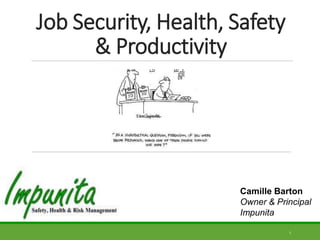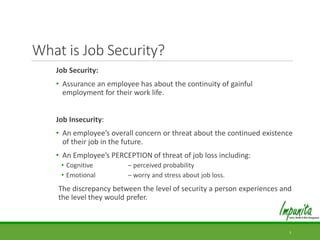Job Security Health
- 1. Job Security, Health, Safety & Productivity 1 Camille Barton Owner & Principal Impunita
- 2. Outline ÂĐIMPUNITA - 2015 2 âĒ Why this topic? âĒ Defining Job Security and Insecurity âĒ Causes of Insecurity âĒ Job Security and Health: Mental and Physical âĒ Health and Productivity âĒ Insecurity and Productivity âĒ Safety Impacts âĒ Impacts on Survivors âĒ Managing and Coping: Helping Others âĒ Managing and Coping: Helping Yourself
- 3. What is Job Security? 3 Job Security: âĒ Assurance an employee has about the continuity of gainful employment for their work life. Job Insecurity: âĒ An employeeâs overall concern or threat about the continued existence of their job in the future. âĒ An Employeeâs PERCEPTION of threat of job loss including: âĒ Cognitive â perceived probability âĒ Emotional â worry and stress about job loss. The discrepancy between the level of security a person experiences and the level they would prefer.
- 4. Causes of Insecurity 4 Market Forces: âĒ Deindustrialization âĒ Technological innovation âĒ Computers âĒ Internet âĒ Robotics & autonomous machines âĒ Globalization âĒ Free market economics âĒ Privatization of public services âĒ Economic climate Organisational/Industry Forces: âĶ Downsizing, mergers etc. âĶ âCasualizationâ of workforce âĶ Workload creep âĶ Organisational culture/leadership âĶ Work group perceptions âĶ Labour market conditions
- 6. Job Security & Health 6 Insecurity is affecting more people in the Australian workforce Insecurity causes economic and social stressors: âĶ Income loss & Economic Stress âĶ Loss of identity/status âĶ Loss of purpose âĶ Social Isolation Is a risk factor for mental and physical health problems Can be a contributor to poor health outcomes with other lifestyle factors: âĶ Diet âĶ Exercise âĶ Stress âĶ Smoking/Drinking
- 7. Mental Health 7 Job insecurity is consistently linked with negative mental health âĶ SF-36 Mental Summary & Kessler 10 scores. A dose â response relationship may exist. Perceived insecurity acts as a chronic stressor Risk factor for depression & anxiety in particular Access EAP recently identified job insecurity as the primary trigger for stress in the Australian mining industry. Those in âprecariousâ employment are at greater risk
- 8. Physical Health 8 âĒ Less consensus within the literature, less research than mental health âĒ Correlation is greater with subjective measures âĒ Associated with work role limitations (physical/emotional issues) âĒ Extended periods of insecurity increased physical symptoms âĒ Associated with increases in medically certified sick leave (30% short term, 20% short) âĒ Objective measures (Allostatic load, BP, cortisol etc.) have mixed results. âĒ One study found that job insecurity had an negative effect on self reported health, but not objective measures (Allostatic load/cortisol)
- 9. Health & Productivity 9 âĒ Health impacts both absenteeism and presenteeism âĒ Presenteeism = health related productivity loss caused by employees coming to work whilst ill or injured. âĒ Presenteeism may result in a greater proportion of productivity loss âĒ Adverse working conditions have health and productivity decrements âĒ D&A and Psychological issues = highest absenteeism risk âĒ Psychological, D&A and fatigue issues = highest presenteeism risk âĒ Comorbidity can increase functional impairment
- 10. Insecurity and Productivity 10 Job Insecurity is associated with poor employee attitude, i.e. reduced: âĶ Job satisfaction âĶ Organisational commitment âĶ Work involvement âĶ Organisational trust âĒ Individual perception of insecurity is influenced by social context and âclimateâ âĒ Leadership influences strength of the insecurity climate âĒ Employees with similar demographics have similar perceptions. âĒ Greater climate strength is associated with poorer individual employee attitudes âĒ Low climate strength can also be a stressor
- 11. Impacts on Safety 11 Globally 260M occupational injuries annually, thatâs 700K/day! Employees with increased insecurity demonstrate: âĶ Decreased safety knowledge âĶ Decreased motivation to comply with safety policies/procedures âĶ Increased accidents/injuries âĶ Increased safety policy violations Work Stress = Increased cognitive failures Insecurity may result in: âĶ Decreased cognitive resources to devote to the job & safety âĶ Short cuts to improve productivity, under reporting of incidents Research found insecurity increased âĶ Likelihood of experiencing and accident âĶ Likelihood accident would not be reported.
- 12. Experience of âSurvivorsâ 12 Organisational restructuring results in âSurvivorsâ Effects of job insecurity remain, particularly in weak labour markets Workload may increase, resources and knowledge lost Survivors experience increased stress which can persist long after the downsizing has taken place High work stress and low perceived control have detrimental effects. Greater downsizing results in higher levels of survivor stress âĶ Also higher levels of hypertension Salaried workers experienced greater stress than âhourlyâ workers âSurvivor Syndromeâ is a recognized issue
- 13. Managing and Coping with Insecurity: Helping Others 13 Listen, help them understand the source of insecurity/stress General Advice: âĒAccept the situation (focus on what you CAN control) âĒLook after health and wellbeing (diet, exercise, relaxation etc.) âĒBe proactive (instead of worrying, plan - helps gain control) âĒCheck in with your personality (predisposition to anxiety etc.?) âĒSeek identity and enjoyment beyond work âĒWrite out/talk out worries âĒSeek help (refer to services and resources)
- 14. Managing and Coping with Redundancy: Helping Others 14 Redundancy is often experienced as a grief/loss cycle âĶ Shock/Disbelief âĶ Depression/Anger/Fear âĶ Acceptance & Moving On Listen, understand where they are, help them understand their experience Help them to identify negative/counterproductive thinking They may not be ready to problem solve, offer to help when they are When ready, help with brainstorming and goal setting, seeing opportunities and problem solving, share resources and knowledge. Refer to other services if they are not coping or at risk of harm (EAP, Lifeline, GP etc.). Taking Care of Yourself after Retrenchment or Financial Loss
- 15. Managing and Coping with Insecurity: Helping Yourself 15 Take your own advice! âĒ Check in with yourself, your feelings and experiences âĒ Helping others can affect you, be aware of your own experience and capacity before jumping in. âĒ Donât take on too much or try to fix everything âĒ You donât have to help if you donât want to or canât, refer to someone/resources that can. âĒ You may be helping others, but who is helping you? Tap into support networks âĒ Seek help for yourself i.e. EAP
- 16. References 16 Rhode, N., Tang, K., Osberg, L. & Prasada Rao, D. (2014). The effect of economic insecurity on mental health: recent evidence from Australian panel data. Griffith Business School Discussion Papers. Griffith University. Holden, L. et al. (2011). Which health conditions impact on productivity in working Australians?. Journal of Occupational and Environmental Medicine, 53 (3), 253 â 257. Modrek, S. & Cullen, M. (2013). Job insecurity during recessions: effects on survivors work stress. BMC Public Health. 13 (929). Sora, B., Cuyper, N., Caballer, A., Peiro, J. & Witte, H. (2013). Outcomes of job insecurity climate: the role of climate strength. Applied Psychology. 62 (3), 382 â 405. Milner, A., Kavanagh, A., Krnjacki, L., Bentley, R. & LaMontagne, A. (2014). Area-level unemployment and perceived job insecurity: evidence from a longitudinal survey conducted in the Australian working-age population. The Annals of Occupational Hygiene. 58 (2), 171 â 181.
- 17. References 17 Naswall, K., Lindfors, P. & Sverke, M. (2012). Job insecurity as a predictor of physiological indicators of health in healthy working women: an extension of previous research. Stress and Health. 23, 255 â 263. Ferrie, J. (2001). Is job insecurity harmful to health? Journal of the Royal Society of Medicine. 94, 71 â 76. Probst, T., Barbaranelli, C. & Petitta, L. (2013). The relationship between job insecurity and accident under â reporting: a test in two countries. Work & Stress. 27 (4), 383 â 402. Rhode, N., Tang, K., Osberg, L. & Prasada Rao, D. (2014). The effect of economic insecurity on mental health: recent evidence from Australian panel data. Griffith Business School Discussion Papers. Griffith University.


















